8 Questions About Calico Cats — Answered
The post 8 Questions About Calico Cats — Answered by catedit appeared first on Catster. Copying over entire articles infringes on copyright laws. You may not be aware of it, but all of these articles were assigned, contracted and paid for, so they aren't considered public domain. However, we appreciate that you like the article and would love it if you continued sharing just the first paragraph of an article, then linking out to the rest of the piece on Catster.com.
Ah, calico cats! Those multi-colored coats that can be arranged into never-ending combinations of patterns make for tons of questions. Do male calico cats exist? Are the rumors about calico cat personalities true? What in the world is a calibby? We’re here with answers to a few commonly asked questions about those mysterious calico cats.
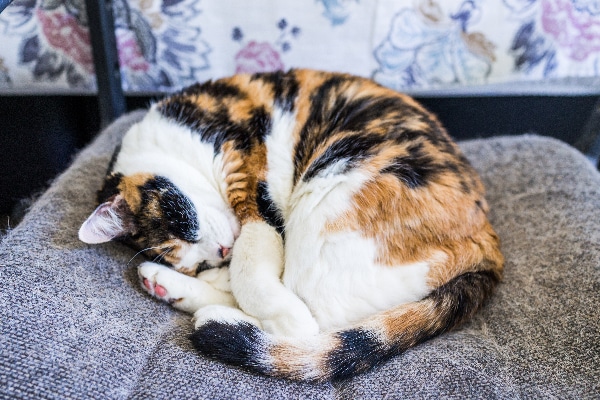
Calicos are not a breed of cat. Photography ©krblokhin | iStock / Getty Images Plus.
1. Is a calico a type of breed?
Nope. Calico refers to a color or pattern of a cat’s fur, not a cat breed.
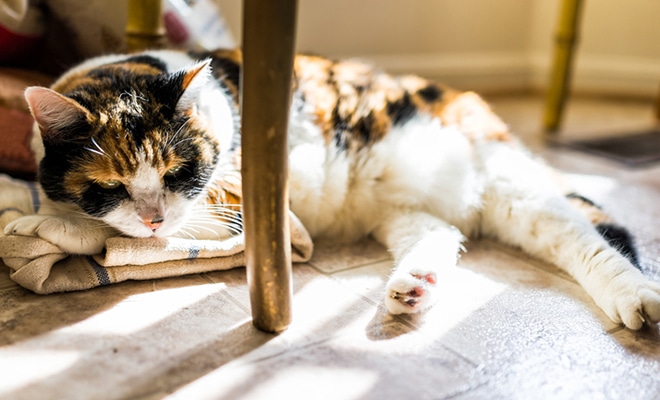
Calico cats get their names from printed fabric. Photography by ©krblokhin | Thinkstock.
2. Where does the name calico come from?
Actually, the term “calico cat” is a description you’ll mostly hear in the U.S. Why? Calico is actually a type of fabric, but when it came to the United States in the 1780s, Americans used the term calico to refer to printed design.
Calico cats are also called brindle, tricolor, tobi mi-ke (Japanese for ‘triple fur’) and lapjeskat (Dutch for ‘patches cat’). Diluted calico cats with lighter coloration are sometimes called calimanco or clouded tiger. Calicos may also be referred to as piebald, which can mean any animal with a white base and pigmented spots.
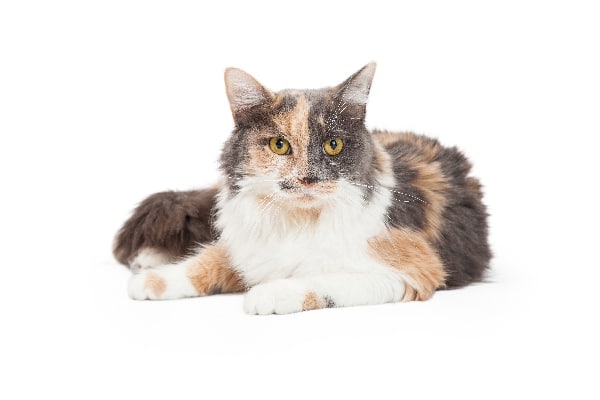
A dilute calico has colors that are a bit more muted than a standard calico. Photography ©adogslifephoto | iStock / Getty Images Plus.
3. What about a calibby? Are there different types of calico cats?
- A standard calico usually has a white coat with large spots of orange and black.
- A dilute calico, as mentioned above, has lighter colorations that result in white coats with large spots of smoky gray and an almost strawberry-blonde color.
- A calibby is a mix of a calico and a tabby cat, where the calico patches of orange and black have the tabby striped or spotted markings.
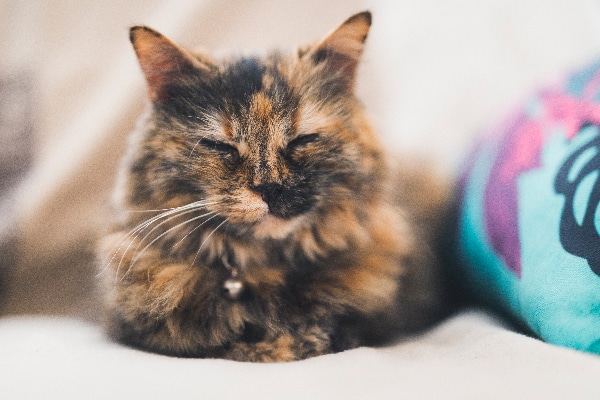
Compare a tortie’s coloring with some of the calico photos. See the differences? Photography ©piranka | iStock / Getty Images Plus.
4. What is the difference between a tortoiseshell cat and a calico cat?
“Tortoiseshells (or torties) have similar coloring to calicos in that they are also contain black and orange in their coat, but the major difference is instead of a mainly white base, tortoiseshells have a black-based coat,” Dr. Gibbons of Just Cats Veterinary Hospital in Stamford, Connecticut, explains. “In addition, instead of distinct spots of orange and white, tortoiseshells are more of an even blend of the black and orange with sometimes white mixed in.”
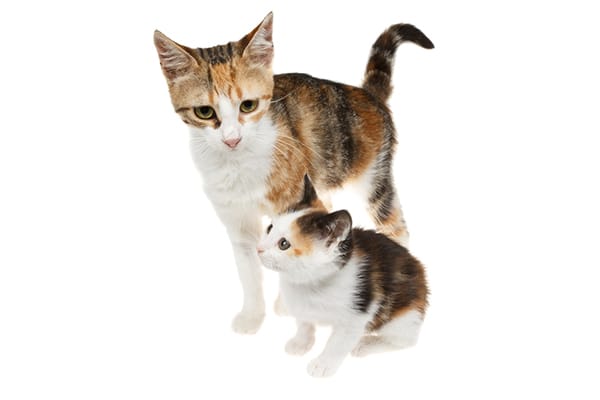
Do male calicos exist? They’re rare, and they’re probably sterile! Photography by Mahlebashieva/Thinkstock.
5. Are all calico cats female?
Most calico cats are females — but not all. Male calicos are rare. “The traditional characteristics for a calico cat are carried on the chromosomes that make cats female, so the majority of calico cats are female,” Dr. Gibbons says. “The possibility of a male calico exists, but they are incredibly rare, and I have yet to see one in 15 years in the veterinary field.”
Approximately one in 3,000 calico cats is male. Also, if you have a male calico, odds are that he’s sterile. Only one in 10,000 of male calico cats is fertile.
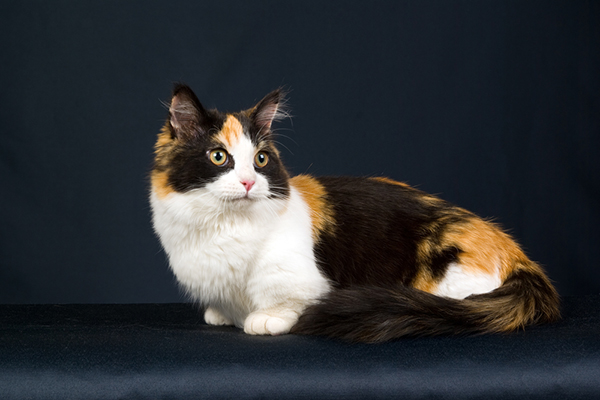
A munchkin calico cat. Photography by Linn Currie / Shutterstock.
6. What cat breeds can be calicos?
According to Dr. Gibbons the following breeds may have calico colorations:
- Domestic Shorthair
- Domestic Longhair
- American Shorthair
- Maine Coon
- Persian
- Exotic Shorthair
- British Shorthair
- American Curl
- Japanese Bobtail
- Norwegian Forest Cat
- Turkish Van
- Turkish Angora
- Munchkin
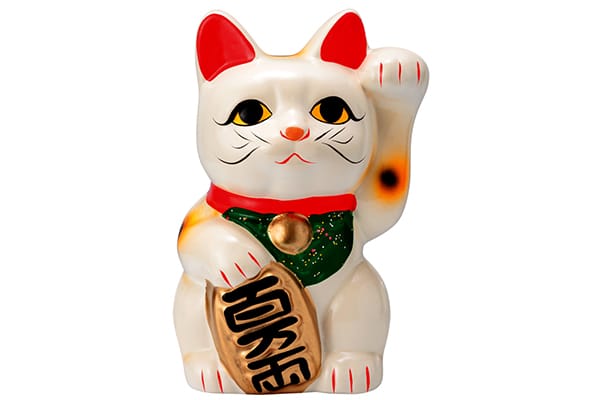
Maneki Neko, aka Lucky Cats or Fortune Cats, are often calico cats. Photography by Danny Smythe / Shutterstock.
7. Are calico cats good luck?
Yes! The aforementioned male calicos are considered especially lucky since they’re so rare.
The Japanese lucky cat, maneki neko, is often calico. Japanese sailors used to travel with calico cats on their oceanic expeditions. Calicos were said to protect the sailors from storms and any angry spirits on board!
Calico cats are also the official state cat of Maryland, due to a similarity in coloring with the state’s bird, the Baltimore oriole, and the state’s insect, the Baltimore checkerspot butterfly.
And, according to Irish folklore, calico cats will cure your warts. Simply rub a calico cat’s tail on your warts in the month of May!
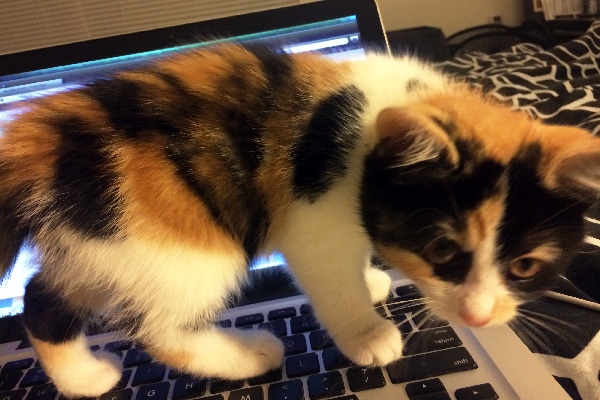
Merritt does not love when we pay attention to other living souls or objects other than her. She prefers to be the center of attention — always. This is her as a tiny kitten, so she’s always been this way! Photography by Cait Rohan Kelly.
8. Why do calico cats get a bad rap for their attitudes?
As the proud mama to a calico cat, Merritt, I am very familiar with the calico attitude that these cats are said to possess in spades (there’s a reason her nickname is Mimi —the same nickname for known diva Mariah Carey). Like the infamous “I don’t know her” feud between Ms. Carey and a certain Jennifer Lopez, my Mimi would prefer not to acknowledge her competitors (in a cat’s case, other cats). This isn’t usually a problem since my other cat Gabby is large, lazy and likes attention selectively. But when we’re petting, kissing or snuggling with Gabby? How dare we! Mimi will meow away, wedge herself into the cuddle or come up and play-smack Gabby.
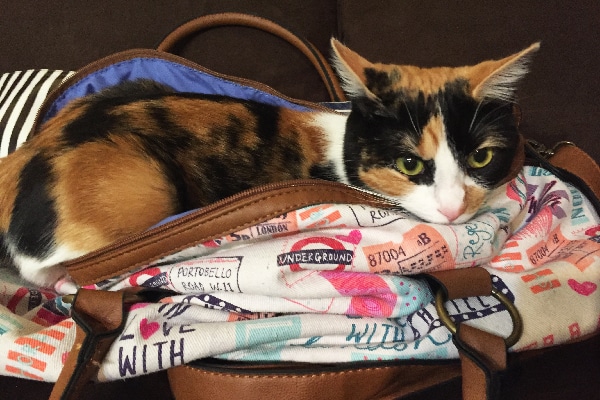
Merritt also likes to make packing impossible. And check out the tabby markings on her head — I think she’s a calibby! Photography by Cait Rohan Kelly.
Yes, my calico loves to be kissed, cuddled, held, paid attention to and — when the mood suits her — even carried around the house like some sort of ancient queen even though she is not a kitten anymore. Mimi is also very talkative and loves to trill away, another attention-grabbing behavior. She is a total diva.
But is this behavior backed by scientific fact? “Calico cats have a reputation for being fiercely independent, and sometimes feisty,” Dr. Gibbons says. “This is not always the case but many live up to their reputation. A recent study by the Journal of Applied Animal Welfare Science says that many owners report more aggression toward owners, when being handled and at veterinary visits in calicos, torbies and tortoiseshells. However, according to the author, analysis ‘of aggression due to handling, as well as aggression displayed during veterinarian visits, showed little difference among coat colors in these settings.’”
So … the answer is still sort of. But I’ve never met a calico who wasn’t sassy. (Let us know in the comments if you have!)
Tell us about your calico cats!
Do you have calico cats? And do your calico cats have a real cattitude? Has anyone ever come across a male calico cat?
Thumbnail: Photography ©cgbaldauf | iStock / Getty Images Plus.
This piece was originally published in 2018.
Read more about cat colors on Catster.com:
- 5 Intriguing Points About Seal Point Cats
- The Orange Tabby Cat — 8 Fun Facts
- What Exactly Is a Mackerel Tabby Cat?
The post 8 Questions About Calico Cats — Answered by catedit appeared first on Catster. Copying over entire articles infringes on copyright laws. You may not be aware of it, but all of these articles were assigned, contracted and paid for, so they aren't considered public domain. However, we appreciate that you like the article and would love it if you continued sharing just the first paragraph of an article, then linking out to the rest of the piece on Catster.com.




Post a Comment